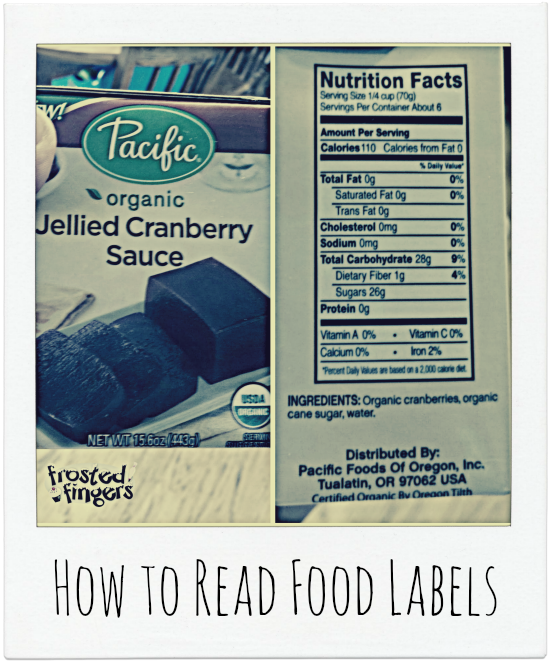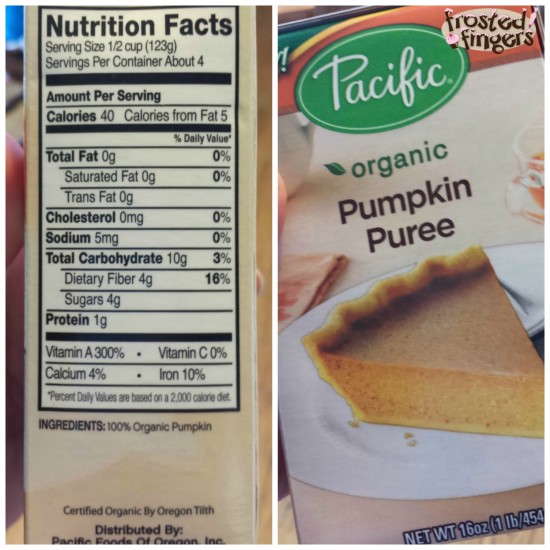Note: This post is sponsored by Illinois Farm Families.
 We are midway through February now. How are you doing on your New Year’s Resolutions? Maybe you chose to eat healthier this year. In order to do that, you need to know what’s in your foods. Have you ever picked up a box or can of food in the store and felt lost? I’m going to do my best here to try to help you learn how to read food labels.
We are midway through February now. How are you doing on your New Year’s Resolutions? Maybe you chose to eat healthier this year. In order to do that, you need to know what’s in your foods. Have you ever picked up a box or can of food in the store and felt lost? I’m going to do my best here to try to help you learn how to read food labels.
 There are so many things to look at when reading labels. First, you can see that that pumpkin puree is Organic. If it has the label organic on it, it has to be certified by the USDA. “In addition, USDA conducts investigations and conducts enforcement activities to ensure all products labeled as organic meet the USDA organic regulations. In order to sell, label, or represent their products as organic, operations must follow all of the specifications set out by the USDA organic regulations.” One of the first things I look at is serving size; especially in a small container of something. Sometimes something small, like a bottle of Gatorade, will actually have 2.5 servings in it and you’ll think you can drink it all in one sitting so you’re actually getting 2.5 x the amount of calories and sugar, etc. This box of pumpkin puree is not much bigger than my hand and has 4 servings in it. It’s only 40 calories, though, so if you WANTED to sit down and eat 4 servings of it, you’re still under 200 calories and 16 grams of sugar. A can of Pepsi is one serving and it has 150 calories and 41 grams of sugar!
There are so many things to look at when reading labels. First, you can see that that pumpkin puree is Organic. If it has the label organic on it, it has to be certified by the USDA. “In addition, USDA conducts investigations and conducts enforcement activities to ensure all products labeled as organic meet the USDA organic regulations. In order to sell, label, or represent their products as organic, operations must follow all of the specifications set out by the USDA organic regulations.” One of the first things I look at is serving size; especially in a small container of something. Sometimes something small, like a bottle of Gatorade, will actually have 2.5 servings in it and you’ll think you can drink it all in one sitting so you’re actually getting 2.5 x the amount of calories and sugar, etc. This box of pumpkin puree is not much bigger than my hand and has 4 servings in it. It’s only 40 calories, though, so if you WANTED to sit down and eat 4 servings of it, you’re still under 200 calories and 16 grams of sugar. A can of Pepsi is one serving and it has 150 calories and 41 grams of sugar!
 This is one label you need to watch for! It looks wonderful at first glance because everything is 0! Look closely, though. What do you see? Serving Size: 1/4 second spray. I don’t know about you, but I can’t count 1/4 of a second. Normally when I spray a dish, it takes me a few seconds to coat the whole thing! Because of the way they label this can, I have absolutely no idea how many calories, fat, sugar, or anything I’m getting with the amount of spray I actually use. If you look, there is a star by the soybean oil and at the bottom says “adds a trivial amount of fat.” How much is trivial and if I’m really spraying for 5 seconds instead of 1/4 or a second, how much fat is that really?
This is one label you need to watch for! It looks wonderful at first glance because everything is 0! Look closely, though. What do you see? Serving Size: 1/4 second spray. I don’t know about you, but I can’t count 1/4 of a second. Normally when I spray a dish, it takes me a few seconds to coat the whole thing! Because of the way they label this can, I have absolutely no idea how many calories, fat, sugar, or anything I’m getting with the amount of spray I actually use. If you look, there is a star by the soybean oil and at the bottom says “adds a trivial amount of fat.” How much is trivial and if I’m really spraying for 5 seconds instead of 1/4 or a second, how much fat is that really?
Let’s get into ingredients now, just a little. The first label I showed had JUST organic pumpkin as the ingredient. Look at this spray label. It has soybean oil, soy lecithin, dimethyl silicone, and a propellant. Out of those items listed, I know what soybean oil is. In today’s world, most people carry a smart phone with them and can look up an ingredient that they don’t know while in a store. I really do wish they’d label the ingredients as what they are, though, so that we don’t need Google to figure it out! I am not a person that goes fully organic or GMO free and I’m not an avid label reader, but I try to do the best for my family as I can.
There are so many great resources out there for label reading. I hope to have helped you get started a little bit. For more label reading information, check out: Decoding Food Labels, Five Misleading Food Labels, and the video embedded below.
Make sure you follow along my journey as an Illinois Farm Family Ambassador this year. I posted an Intro to Illinois Farm Families and Why Farmers Use GMOs. I’ll also be visiting some farms this year and sharing what I learn with you as well.
With a soy allergy in my house, label reading is a must. But I often forget to look at the serving size when doing so. I’ll have to be a little more attentive.